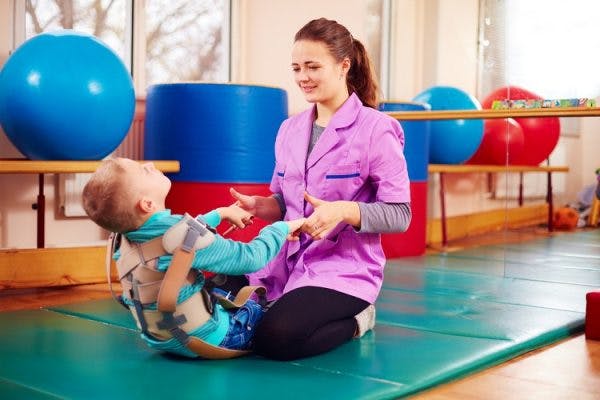Cerebral palsy is a lifelong condition caused by damage to the areas of the brain that affect movement. While the brain damage that caused cerebral palsy will not progress over time, it also cannot reverse itself. This is why it is important to address the effects of cerebral palsy early on. Early intervention for cerebral palsy can minimize the secondary effects of brain damage through neuroplasticity (the brain’s ability to adapt and rewire itself).
Intervening early in life can promote the development of proper movement patterns and optimize one’s functional abilities for a better quality of life. This article will explain how early intervention may boost functional abilities by exploring the following topics:
- Why is early intervention for cerebral palsy ideal?
- How the brain adapts early in life
- Importance of early diagnosis
- Goals of early intervention
- Examples of early intervention
- Making early intervention fun
Why is Early Intervention for Cerebral Palsy Ideal?
Early intervention for cerebral palsy is ideal because an infant’s brain is undergoing a key period of development. When brain damage occurs, such as that which occurs in those with cerebral palsy, the typical patterns of development are disrupted. As a result, infants may begin missing significant developmental milestones or progressing toward them more slowly than expected.
If not addressed, these delays have the potential to cause the development of poor movement patterns and habits that could affect one’s entire life. Early intervention can combat this and promote optimal skill development from the start.
Additionally, beginning interventions for cerebral palsy early in life allows infants and toddlers to take advantage of the brain’s increased neuroplasticity (the ability to adapt and rewire itself).
How the Brain Adapts Early in Life (and Throughout Life)
Within the brain are millions upon millions of neural pathways. These pathways are formed by repetitive patterns. The more often a pattern is repeated, the stronger a neural pathway becomes.
The brain is always ready to make new pathways and reorganize those that already exist through a process called neuroplasticity. This allows individuals to learn new skills, as well as to adjust, improve upon and perfect developing skills.
To further understand this, think of a child learning to walk. They start by taking a couple of steps holding on to a piece of furniture, then bravely step away to take a few shaky steps on their own. The more they practice, the better they are able to walk, until they are toddling all over.
Through neuroplasticity, the neural pathways involved in walking are created, modified and strengthened until the pathway becomes so strong that walking comes naturally.
The brain is always undergoing changes through neuroplasticity, regardless of one’s age. However, there are certain times of life that different areas of the brain experience higher levels of neuroplasticity. Generally, the brain has highest levels of neuroplasticity early in life.
With this in mind, early intervention is ideal because the younger the individual, the more plasticity their brain has, and the easier it is to learn new skills and replace bad habits. It’s important to understand that the brain will always have neuroplasticity and that recovery is possible at any age.
As long as you’re practicing proper movement patterns and stimulating the brain, the brain will adjust and strengthen its neural pathways. However, early intervention for cerebral palsy is ideal because it takes advantage of a young brain’s eagerness to learn and quick adaptability.
Early Intervention Requires Early Diagnosis

Developmental delays are one of the first signs of cerebral palsy, but a developmental delay does not mean your child has CP. Many children with mild cerebral palsy are not diagnosed until they’re 2-5 years old because symptoms may be unclear. Some doctors hesitate to diagnose infants with mild symptoms because they may end up not having cerebral palsy at all. However, waiting until symptoms escalate may also be problematic.
Although cerebral palsy presents itself in a variety of ways, common indications that an infant or toddler should be further assessed to determine if they have cerebral palsy include:
- Delayed sitting ability in infants under 8 months old (typically children can sit without assistance between 6 and 7 months)
- Delayed walking in children over 8 months old (typically children begin walking between 10 and 14 months, and can walk well by 18 months)
- Strong hand preference before the age of one (typically hand dominance is not well established until age 2 or 3)
Even if it is determined that a child’s developmental delays are not caused by cerebral palsy, it is important to discuss with their doctor whether they may still benefit from early intervention.
Although the brain damage that caused cerebral palsy will not worsen over time, primary and secondary conditions of CP like spasticity and pain can. Thus, if you notice your child demonstrating any of the above signs or other developmental delays, advocate for them to be further evaluated by your pediatrician to determine if early intervention is appropriate for them.
Goals of Early Intervention for Cerebral Palsy
Since cerebral palsy presents itself differently in each individual, treatment goals may vary. However, generally speaking, the goals of early intervention for cerebral palsy are to:
- Optimize mobility and coordination through interventions that promote neuroplasticity
- Prevent or manage the primary and secondary complications of cerebral palsy (like pain, scoliosis, hip displacement, and speech impairments) so that motor impairments are minimized and don’t interfere with development
- Provide families with tools they can use to promote reaching appropriate developmental milestones and optimize functional skills for improved quality of life
Early intervention training to promote neuroplasticity should be motivating, task-specific, and highly repetitive.
The more effective a task is at motivating your child, the easier it will be for them to perform the repetitions they need for neuroplasticity to occur.
Examples of Early Intervention for Cerebral Palsy

What does early intervention consist of? Since every case of cerebral palsy is unique, management requires an individualized approach.
Frequently, as early intervention occurs with infants and toddlers, parents and other family members are encouraged to participate in the therapy sessions. They may also be recommended to follow a home program to complete with their child daily.
Carrying over early intervention activities and integrating them into a family’s daily routine can greatly increase the number of repetitions of movements the child completes, which promotes neuroplasticity.
If your child has very minor muscle stiffness, early intervention may be as simple as a therapist educating the family on how to perform daily stretching for optimal motor development.
In contrast, children with more complicated symptoms may need to use a combination of multiple management interventions like:
- Physical therapy to improve joint range of motion, strengthen underused muscles, and practice moving with correct form through functional exercise and activities
- Orthotics to promote proper musculoskeletal alignment and gently stretch spastic (tight) muscles
- Occupational therapy to practice activities of daily living and fine motor skills
- Speech therapy to strengthen muscles around the mouth necessary for communication and feeding
Early intervention techniques that therapists use may vary, but they all tend to include the same components:
- Evaluation to determine the child’s current skill level and develop a plan for further intervention
- Treatment to encourage functional development through personalized activities and exercises
While these therapies may sound intimidating at first, children often come to really enjoy their therapy sessions. This is because therapists, especially those who specialize in early intervention and pediatrics, often integrate play into their sessions.
Making Early Intervention Fun
Not only does playing during therapy make the treatment more fun, but it also promotes optimal skill development and neuroplasticity as children tend to be motivated to complete more repetitious movements during engaging play than rote exercises.
Although activities used during early intervention vary by discipline and therapist, some examples that may be used during early intervention for cerebral palsy include:
- Sitting on a therapy ball or wiggly surface to improve core strength
- Doing crafts or playing games with small pieces, such as Mr. Potato Head, to encourage fine motor coordination
- Making various funny faces to strengthen muscles around the mouth
- Crawling or walking through an obstacle course for gross motor development
As you can see, early intervention can be fun and engaging for infants and toddlers, and the possibilities of activities that can be used to promote motor skills are endless!
Understanding Early Intervention for Cerebral Palsy
Early intervention is ideal for infants with cerebral palsy because it takes advantage of the extremely adaptive features of the developing brain.
Although early intervention will not “cure” cerebral palsy, it can significantly improve motor functions and prevent or delay the development of secondary complications.
Don’t wait until symptoms become problematic. Seek early intervention therapies to promote neuroplasticity and maximize mobility.











